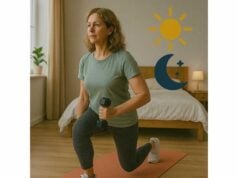
Sleep quality often slips in midlife just as stress loads rise. Breathwork gives you a lever you control in minutes, without equipment or side effects. Proper pacing, gentle mechanics, and short daily sessions can lower physiological arousal, settle a racing mind, and nudge your nervous system toward recovery. This guide explains why slow, structured breathing works, then translates the most useful methods—4-7-8, box breathing, and resonance breathing—into practical protocols you can repeat. You will learn how to pair technique with timing, what to track, and when to avoid certain practices. If you want to situate breathwork inside a broader recovery plan, explore our practical hub on sleep and stress for longevity.
Table of Contents
- Why Breathwork Calms the Nervous System in Aging
- 4-7-8 Breathing: Protocol, Timing, and Common Mistakes
- Box Breathing and Resonance Breathing: When to Use Each
- HRV Biofeedback Basics: Devices, Pacing, and Targets
- Daytime Practice vs Evening Wind Down: Building Consistency
- Safety Notes: Dizziness, Hyperventilation, and Who Should Avoid
- Stacking Breathwork with Meditation, Light, and Sleep Routines
Why Breathwork Calms the Nervous System in Aging
Breathing is the only autonomic function you can steer in real time. When you slow and smooth the breath, you shift the balance between the sympathetic (“fight or flight”) and parasympathetic (“rest and digest”) branches of the autonomic nervous system. Two mechanisms explain most of breathwork’s benefits:
- Respiratory sinus arrhythmia (RSA): Heart rate rises on inhale and falls on exhale. Slow, regular breathing amplifies this oscillation and strengthens vagal influence—the parasympathetic brake on the heart. The result is a calmer baseline and faster recovery from stressors.
- Baroreflex tuning: Blood pressure sensors in arteries trigger reflexes that stabilize circulation. Breathing at a comfortable slow pace (about 4.5–7 breaths per minute for most adults) lines up breathing, heart rate, and blood pressure in a cooperative rhythm, improving beat-to-beat stability.
Aging changes the terrain. Vascular stiffness and lower baseline heart rate variability (HRV) can blunt stress resilience. The good news is that slow, paced breathing still engages the vagus nerve and the baroreflex even when resting HRV is modest. Many adults in their 40s, 50s, and 60s notice that five to ten minutes of structured breathing reduces muscle tension and rumination enough to shorten sleep latency, especially when paired with a fixed lights-out time.
Three practical principles guide any protocol:
- Pace: Most recovery effects appear when you breathe slowly and evenly. For many, the “sweet spot” is around 6 breaths per minute (a 10-second cycle). Do not chase exact numbers; comfort and consistency matter more than precision.
- Exhale bias: Slightly longer exhales tilt the system toward parasympathetic dominance. You will feel this as a gentle drop in heart rate toward the end of the breath.
- Mechanics: Keep the breath low and quiet. Let the belly and lower ribs expand first; avoid shrugging the shoulders or straining the throat. Rest the tongue on the palate, jaw unclenched.
What you should feel: a sense of space in the chest, less urgency in thoughts, and easier transitions between wake and sleep. What you should not feel: air hunger, tingling, or dizziness. If that shows up, you are forcing the pace or volume. Back off, reduce breath depth, and return to effortless control.
Finally, think in weeks, not minutes. Breathwork builds a skill: downshifting the nervous system on cue. Ten calm minutes across most days will outperform one perfect session.
4-7-8 Breathing: Protocol, Timing, and Common Mistakes
4-7-8 is a simple ratio pattern: inhale for a comfortable count of 4, hold for 7, exhale for 8. It aims to slow the breath and lengthen the exhale without complicated pacing devices. Done gently, it reduces cognitive arousal before bed and helps interrupt stress spikes during the day.
Baseline protocol (beginner-friendly)
- Sit or lie down with the spine neutral. Place one hand on the low ribs.
- Seal the lips lightly; inhale through the nose for a silent 4-count. Let the lower ribs widen; keep the neck soft.
- Hold the breath for a relaxed 7-count. Let the chest stay easy; avoid bracing.
- Exhale through pursed lips for a smooth 8-count, as if fogging a window. Empty comfortably, not forcefully.
- Repeat for 4 cycles the first week, then work up to 8 cycles. When practiced for sleep, stop when you feel heavy-eyed rather than finishing a quota.
Timing options
- Evening wind down: 4–8 cycles about 60–90 minutes before bed, then again at lights out if needed.
- Stress interruptions: 1–3 cycles after email blocks, before meetings, or when rumination kicks up.
- Night awakenings: 2–4 cycles after a bathroom trip, in a dark room, eyes closed.
Common mistakes to avoid
- Overholding. A hard 7-count hold can trigger air hunger and a rebound gasp. Keep the hold gentle; shorten it if you feel strain.
- Overbreathing. Big, noisy breaths lower CO₂ too much and can cause tingling or lightheadedness. Use smaller, quieter breaths; think “slow” rather than “deep.”
- Neck and jaw tension. If your shoulders lift on every inhale, you are pulling air with accessory muscles. Reset: one hand on the belly, one on the chest, and breathe so only the lower hand moves.
- Forcing the exhale. The 8-count should taper to a whisper, not a push. If you run out of air at 6, call it 6 and extend gradually over weeks.
When 4-7-8 is not enough
If bedtime worry is the main barrier, pair 4-7-8 with a five-minute “cognitive off-ramp” (brief journaling, tomorrow’s to-do list, or a scripted worry period). If insomnia persists more than a month, learn stimulus control and sleep scheduling basics from a practical CBT-I approach in our guide to structured insomnia skills.
Used consistently, 4-7-8 teaches your body a predictable downshift: slower pulse, quieter mind. Think of it as a low-effort switch, not a silver bullet.
Box Breathing and Resonance Breathing: When to Use Each
Box breathing and resonance breathing are cousins with different goals.
Box breathing (even holds): Inhale–hold–exhale–hold in equal lengths (e.g., 4-4-4-4 or 5-5-5-5). The even corners promote focus and emotional steadiness. It works well for pre-performance nerves, public speaking jitters, and brief resets between tasks. The uniform holds add structure your mind can rest inside, like counting steps on a staircase.
- Protocol: Start with 4-4-4-4 for 1–3 minutes. Each phase should feel smooth and unforced. If you notice strain, drop to 3-3-3-3 or lengthen only the exhale.
- Best use cases: Anticipatory stress, “edge” moments at work, and brief composure drills. Avoid heavy use right before bed if you find the holds stimulating.
Resonance breathing (around 6 breaths per minute): Here the goal is physiological tuning. By breathing at a comfortable slow pace (often near a 5- to 6-second inhale and a 5- to 6-second exhale), you amplify RSA and strengthen baroreflex efficiency. Some people use a very slight exhale bias (e.g., 4-to-6) in the evening.
- Protocol without devices: Count a steady 5 in / 5 out (or 4/6 in the evening). Use a metronome app or an audio track with soft chimes to maintain cadence.
- What to feel: A gentle sway of the breath with no breath hunger. If you cannot sustain the pace comfortably, widen the counts by 1–2 seconds total, not per phase.
Choosing between them
- Need calm focus now? Use box breathing for 1–3 minutes. It is a mental anchor with quick effects.
- Need deeper recovery and sleep benefits? Choose resonance breathing for 5–10 minutes. It trains the cardiovascular reflexes that govern arousal.
Troubleshooting
- If box breathing feels tight, shorten the holds or substitute “shape breathing”: inhale 4, exhale 6, no holds.
- If resonance breathing makes you yawn or sigh repeatedly, you are over-inhaling. Reduce breath size while keeping the same cadence.
For readers interested in how breathing patterns show up in recovery metrics (resting HRV, morning readiness), our primer on HRV and recovery explains what the numbers do—and do not—mean.
The big picture: box breathing steadies the mind; resonance breathing conditions the reflexes. Both are useful when applied on purpose.
HRV Biofeedback Basics: Devices, Pacing, and Targets
HRV biofeedback (HRVB) adds a simple loop to resonance breathing: you breathe to a cue while watching a real-time signal (usually heart rate or a coherence score). The aim is not “higher HRV at all costs,” but smoother oscillations and efficient recovery.
Core elements of a good HRVB session
- Sensor: A chest strap is most accurate for beat-to-beat data. Ear-clip and finger optical sensors can work if you sit still and warm your hands. Wrist devices vary widely in fidelity at short timescales.
- Cue: Visual pacers (moving circle, expanding bar) or audio pacers (tones) set the cadence. Start with 5 in / 5 out and adjust by feel.
- Feedback metric: Some apps display a frequency-domain graph (a peak near ~0.1 Hz is common), others show a simplified “coherence” score. Treat these as guides, not grades.
Targets to guide practice
- Cadence: Explore 4.5–7 breaths per minute. Many settle near 6 bpm. If your “best” cadence changes day to day, do not chase decimals—choose the most comfortable slow pace that feels sustainable for 5–10 minutes.
- Session length: Start with 5 minutes, build to 10–15 on training days. Quality beats duration. Two short sessions (morning and evening) often outperform one long block.
- Perceived shift: After a good session, you should feel calmer and less effortful, with freer breathing and softer facial muscles.
Common pitfalls
- Over-fixation on numbers: HRV varies with hydration, temperature, and stress. Use the graph to learn your pace, not to judge your worth.
- Breathing too big: Chasing higher scores with oversized breaths leads to lightheadedness. Keep breaths shallow-to-moderate and rhythmic.
- Inconsistent posture: Sit tall with supported lower back. Slouching compresses the diaphragm and invites neck breathing.
Selecting a tool
Choose software that lets you adjust pacing, supports both visual and audio cues, and logs sessions so you can see trends across weeks. If you already wear a general-purpose tracker, use it to mark session times and to review sleep changes, but do not expect perfect alignment between nightly HRV and how calm you feel right after practice. For a broader view on which metrics matter—and which to ignore—see our practical overview of using wearables wisely.
When used three to five days per week, HRVB can condition a reliable downshift you can call on during evening wind downs or mid-day stress spikes. Think of it as “breathing with mirrors,” a way to learn faster by seeing what your body is doing.
Daytime Practice vs Evening Wind Down: Building Consistency
Breathwork works best when it becomes a habit. Two daily anchors make that likely: a brief daytime session that raises your skill when you are alert, and a pre-sleep session that lowers arousal when you need it most.
Daytime practice (skill building)
- Timing: Late morning or mid-afternoon, away from heavy meals and caffeine peaks.
- Duration: 5–10 minutes of resonance breathing or HRV biofeedback, three to five days per week.
- Goal: Smooth, quiet cycles; less chasing of numbers; a felt sense of control. Treat it like learning an instrument—short, regular practice.
Evening wind down (state change)
- Timing: Start 60–90 minutes before bed, alongside lights dimming and screens shifting to low-arousal content.
- Method: 4-7-8 or 5-minute resonance breathing with a longer exhale bias. If you are sensitive to breath holds, skip them at night.
- Goal: Reduce presleep tension, shorten sleep latency, and reduce awakenings triggered by “problem-solving brain.”
Weekly schedule template
- Mon/Wed/Fri: Midday resonance breathing (5–10 minutes). Evening 4-7-8 (4–8 cycles).
- Tue/Thu: HRV biofeedback (8–12 minutes). Evening light stretching plus 5 minutes of exhale-biased breathing.
- Weekend: One flexible session; if you are traveling, do a 2-minute “micro-set” (inhale 4, exhale 6) before bed.
Tracking what matters
- Lagging indicators: Sleep latency, night awakenings, and morning energy over two weeks.
- Leading indicators: Pre- and post-session calmness (0–10 scale) and ease of breathing. These tell you if the method is working tonight before sleep data shows it.
How breathwork fits with your day
- Busy days: two one-minute micro-sets beat skipping. Use elevator waits or calendar breaks to breathe quietly with eyes open.
- Travel days: noise-canceling headphones plus audio pacing hide the practice in plain sight.
If your main goal is a more stable body clock, combine breathwork with consistent light habits and meal timing. For step-by-step circadian scaffolding, see our practical guide to resetting your body clock.
Safety Notes: Dizziness, Hyperventilation, and Who Should Avoid
Breathwork is generally safe when done gently, but technique matters. Most adverse sensations come from overbreathing—taking overly large breaths at slow rates—which lowers carbon dioxide too much and produces lightheadedness, tingling, or a “floating” feeling.
Preventive guardrails
- Small, quiet breaths. You should not hear your inhale across the room. Keep the mouth soft; avoid gulping air.
- Effortless holds. If you use box or 4-7-8, the holds should feel easy. Shorten them if you feel any strain.
- Posture and support. Sit or lie down during early sessions. If you stand, keep a hand on a chair for balance.
Stop the session if you notice
- Dizziness, numbness, chest pain, or unusual shortness of breath.
- Urge to yawn repeatedly or sigh heavily (a sign you are breathing too big).
- Anxiety rising instead of falling after two minutes.
Who should be cautious or seek guidance
- Significant lung or cardiac disease, especially COPD, severe asthma, pulmonary hypertension, or recent cardiac events. Discuss slow-paced breathing with your clinician; they may suggest specific limits on holds and volume.
- Pregnancy: Avoid strong breath holds and straining; choose gentle, even-paced breathing only.
- Panic disorder: Long holds can backfire. Use exhale-biased, no-hold patterns with a therapist’s input.
- Sleep apnea: Breathwork is not a treatment for airway collapse. If you have loud snoring, witnessed apneas, or morning headaches, prioritize evaluation and treatment first; for basic signs and next steps, see our guide to apnea essentials.
Medication considerations
- Sedatives, alcohol, and some pain medicines change chemoreceptor sensitivity. Do not combine deep relaxation drills with doses that already lower alertness; practice earlier in the evening.
- If you use inhalers, continue them as prescribed. Breathwork is a complement, not a replacement.
Keep the overall stance gentle. Breathwork should feel restorative during and after, not like a workout. When in doubt, shorten the session, remove holds, and aim for a soft, steady exhale.
Stacking Breathwork with Meditation, Light, and Sleep Routines
Breathwork is powerful alone; it is even better when paired with simple behaviors that reinforce the same signal: “downshift now.” Build a short stack you can run most nights.
A 15-minute evening stack
- Lights and screens (2 minutes): Dim lamps to the lowest comfortable setting; switch TVs and devices to warm tone at low brightness. Put the phone on Do Not Disturb.
- Body unlock (3 minutes): Gentle neck rolls, shoulder shrugs, and a slow forward fold. No stretching to discomfort—just release.
- Breathwork (5–8 minutes): Choose 4-7-8 or resonance breathing with a slight exhale bias (e.g., in 4, out 6). Eyes closed; jaw soft.
- Mind quiet (2 minutes): Brief body scan or a single-word anchor (“soft,” “quiet”). If your mind wanders, return to the word on each exhale.
Morning stack for circadian strength
- Light: Get outdoor light within an hour of waking, even on overcast days. Two short 5-minute exposures beat none.
- Movement: A brisk walk or easy mobility. Use 2–3 minutes of steady nose breathing to find a calm rhythm you can revisit later.
- Attention: A single minute of slow breathing before opening messages reinforces your ability to choose focus.
Layering with other recovery levers
- Nutrition: Leave at least two to three hours between the last meal and bedtime to reduce reflux and arousal. If late meals are unavoidable, keep them lighter and higher in protein than sugar.
- Caffeine and alcohol: Caffeine lingers; set a personal cutoff 8–10 hours before bed. Alcohol shortens deep sleep; plan for earlier, smaller servings on social evenings. For timing details and practical guardrails, review our concise guide to stimulus timing.
- Meditation: If you already meditate, use two minutes of paced breathing to “enter” practice. Many people find that breath cues settle them faster than jumping straight into open monitoring.
When life gets noisy
- On travel days, swap your full stack for a “stealth” version: audio pacer in headphones, eyes half-closed, even breathing for three minutes before bed. Keep lights low. Let “simple and repeatable” beat “perfect.”
When you design the same moves for the same time each night, the routine becomes a cue. Over a few weeks, your body starts the downshift before you sit down, and sleep follows more readily.
References
- Brief structured respiration practices enhance mood and reduce physiological arousal (2023) (RCT)
- Methods for Heart Rate Variability Biofeedback (HRVB): A Systematic Review and Guidelines (2023) (Systematic Review)
- Effects of voluntary slow breathing on heart rate and heart rate variability: A systematic review and a meta-analysis (2022) (Systematic Review)
- The Effects of Presleep Slow Breathing and Music Listening on Polysomnographic Sleep Measures – a pilot trial (2020) (RCT)
Disclaimer
This article is educational and does not substitute for medical advice, diagnosis, or treatment. Always consult a qualified clinician before starting breathwork if you have heart or lung disease, are pregnant, experience panic attacks, or have symptoms of sleep apnea. If insomnia or daytime sleepiness persists beyond several weeks, seek professional evaluation.
If you found this guide useful, please consider sharing it on Facebook, X (formerly Twitter), or any platform you prefer, and follow us for future updates. Your support helps us continue producing practical, evidence-informed resources.










